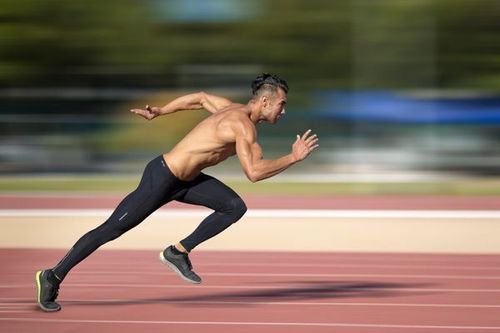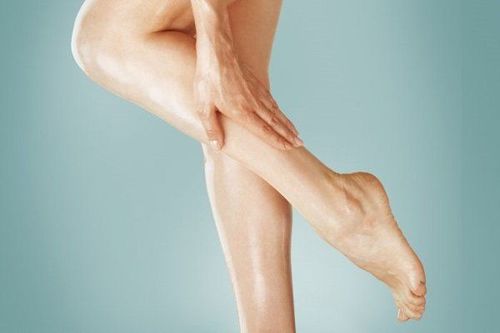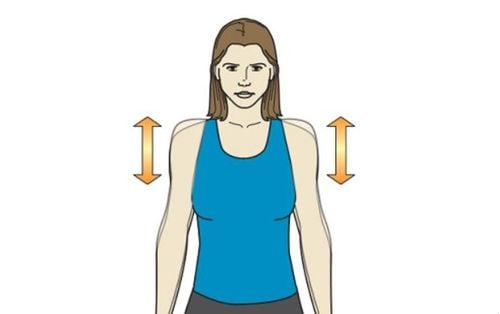The 100m sprint, also known as short-distance running, is a popular event in sports competitions, including student and university tournaments. However, not everyone fully understands the proper techniques for the 100m sprint to achieve the best results and avoid unwanted injuries. Below is a guide to the correct 100m sprint technique.
1. Warm-up before sprinting
The purpose of warming up is to help muscles contract more quickly and prepare for intense training. Warming up allows the body to gradually adapt to high-intensity movements, reducing the risk of injuries in 100m sprinting. Specifically:
- 5-minute cardio: Athletes should warm up by jogging around the track before training.
- Stretching and mobility exercises: Focus on dynamic movements and active stretching. These types of stretches and drills will help achieve the warm-up goals before executing the 100m sprint technique.
- Technical drills: Sprint drills must be performed correctly. Doing so will help improve acceleration and maximum sprint speed.
- Acceleration training: When practicing the 100m sprint technique, it is essential to work on acceleration. This is crucial for races. Perform acceleration sprints 3–4 times, increasing the number of repetitions in subsequent training sessions.

2. Preparing for the 100m sprint
Preparation is an extremely important part of sprinting. A good warm-up ensures the following steps can be executed effectively. The preparation phase greatly impacts the 100m sprint technique and overall performance.
- Step 1: Place both hands on the ground before the starting line, shoulder-width apart. Spread your fingers slightly to form an arch or bridge shape. This helps stabilize the body and allows for an explosive start.
- Step 2: Position your dominant foot forward, aligned with your hands. The non-dominant foot should be placed behind. A key point to remember is that both feet must touch the track surface; failure to do so may result in a false start.
- Step 3: Lower the knee of your back leg to the track so that your rear thigh is perpendicular to the ground. Keep your head and back naturally straight—avoid hunching or bending forward. Your eyes should focus about 40–50cm ahead of the starting line. Shift your body weight onto your hands, front foot, and back knee.
3. Executing a proper start
After completing the preparation steps, the next crucial phase of the 100m sprint technique is the start.
When the “Set” command is given, shift your body weight forward and raise your hips to at least shoulder level. Lean your shoulders 5–10cm forward beyond the starting line. Maintain this position until the next signal from the official.
Upon hearing the starting signal, forcefully push off with both legs while simultaneously driving your arms forward in opposition to your legs. This movement is essential for maintaining balance and generating maximum propulsion.
Quickly bring your back leg forward to complete the first step without overextending it. For the front leg, extend fully through all joints before leaving the starting block. Rapidly bring the front leg forward to complete the second step, then continue with the following strides.
4. Drive phase
Once both hands leave the ground, you enter the drive phase. At this stage, sprint speed gradually increases.At the same time, the forward lean of the upper body gradually decreases. Arm movement becomes less aggressive as momentum builds.
During the initial strides, your feet should be placed slightly wider apart, then gradually brought closer together.
Sprint speed during the drive phase depends on stride length. Ideally, each step should be half a foot longer than the previous one, stabilizing after 9–11 strides.
Consistent training with proper technique is essential for achieving high performance.

5. Mid-Race phase
After completing the drive phase, you enter the mid-race phase. The primary objective here is to maintain the high speed gained from the drive phase. Key points to focus on during this stage:
- The front leg transitions from an upright position into a powerful push-off, while the trailing leg moves forward. The knee of the trailing leg should be lifted close to parallel with the ground.
- The push-off motion significantly affects sprint speed during this phase. Therefore, it must be executed quickly, forcefully, and in the correct direction. The trailing leg should move forward rapidly and precisely to support the push-off motion.
- As soon as the front foot makes contact with the ground, the shoulders and hips must shift forward. This transition enables a smooth change from landing to push-off.
- Arms should swing opposite to the legs in rhythm with the stride. Keep hands loosely clenched or fingers extended, and elbows bent while sprinting.
6. Finishing the Race
When sprinters are 15–20m from the finish line, they must focus on maintaining top speed. To maximize the push-off effect, lean the body slightly forward. Increase speed within this range to finish as quickly as possible. A runner is considered to have finished the race when any part of their upper body (excluding the head and arms) crosses the vertical plane of the finish line. Therefore, in the final meters, you should lean your upper body forward or rotate your torso to ensure the shoulder crosses the finish line first.
In 100m running technique, avoid jumping towards the finish line, as it will slow you down. Continue running a few extra steps after crossing the finish line to maintain balance and prevent falling. Never stop suddenly.
For individuals with health conditions such as cardiovascular disease, diabetes, or a history of injuries, it is essential to consult a doctor or specialist before engaging in sprinting.
Source: thespeedproject.com
To arrange an appointment, please call HOTLINE or make your reservation directly HERE. You may also download the MyVinmec app to schedule appointments faster and manage your reservations more conveniently.








